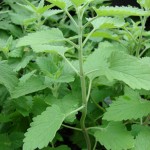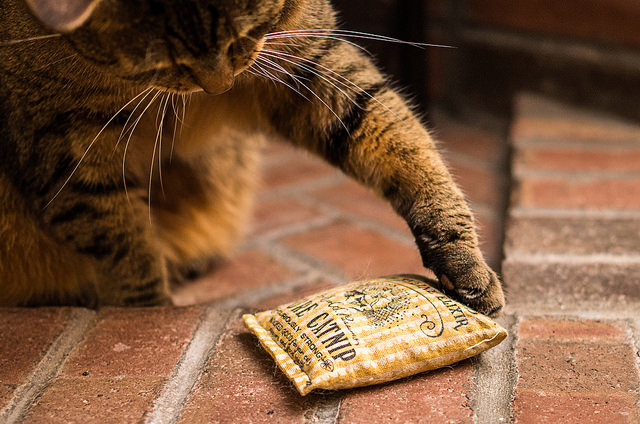Let’s see what is catmint and how you can use it to please your cats.
In nature, cats love to eat vegetables, or rather the herbs that are available, also in the fields.
It’s a physiological need that often domestic cats (especially our feline friends staying indoors and never going out) fail to satisfy.
It being understood that in every house where there comes a pet, should be eliminated all the potentially dangerous plants (many of the common apartment ones are toxic to dogs and cats when ingested).
It may be good then, to grow at home some healthy catnip.
Catmint Effect on Cats
It’s demonstrated how this plant has a particularly beneficial effect on many cats, but also on other big cats (like lynx, leopards, jaguars, etc.).
Have you ever asked about how tigers, lions or leopards react to catnip?
Here’s a very interesting video created by “Big Cat Rescue” on YouTube :
The scientific name is “Nepeta cataria” and is a perennial plant native of Europe and Asia.
It grows very easily outdoor, so much that it is often considered weeds, especially in the U.S. and Canada where it is widespread.
Its active ingredient is the Nepetalactone (in the leaves and the stems) that if inhaled (maybe when the cat sniffs the grass) causes curious and unusual changes in your pet’s behavior.
With this regard, have fun watching this video of a cat going crazy for catmint!
From the biochemical point of view, catnip seems to have correlations with marijuana, but it is certainly not dangerous for the pet.
Quite the contrary.
The effects of this plant, however, is not detected in all cats.
Around 10-30% of our feline friends do not react to catmint, regardless of age. They speak of a genetic predisposition, the “catnip gene”.
According to studies, the cats who respond to this plant are particularly sensitive to the smell of nepetalactone and would eat or sniff catswort, touching it with their legs to make further disperse of the aroma.
Let’s see the most common effects:
– Happyness
– Intoxicated drunken behavior or appearance
– Euphoria
– Excitement
– Hyperactivity
– Playfulness
– Sedation
Why Should You Give Catmint to Your Feline Friend?
Simply because your cat becomes happy!
It can be used as a reward during training (perhaps to accustom the cat to scratch in a specific place or when you teach him to sleep in his place).
It can be a good way to encourage your cat to do some exercise or can help him relax.
When cats come in touch with catnip they may also behave like heat season: rubbing their heads and body on the plant, jumping, rolling around, vocalizing and salivating.
These effects last for about 5-15 minutes, after which our feline friend becomes temporarily immune to catmint for around 30 minutes.
Some ethologists and other scientists believe that this substance stimuli just the parts of the brain related to the sexual sphere, instead of another pleasure center.
Catmint is sold in pet stores and even supermarkets (here’s the link to Amazon), under various formulations: plant seeds, bulbs, potted plant already grown, dried form, spray or essential oil.
Catnip can be used as a prize in the educational phase of your cat, or as relaxing.
Sometimes it has an aggressive effect (especially on uncastrated male cats), so you should avoid it at the first signs.
In most cases, however, this plant (also called cat’s heal all) is used for domestic cats to facilitate the escape of the bolus they accumulate with daily cleaning of the hair (I personally don’t have this issue, as I brush my cat every morning).
There are many types of this plant, although the real one is just the Nepeta cataria.
Finally, consider it as nonaddictive and completely harmless to cats.
Photo credit at https://www.flickr.com/photos/tehchix0r/




My cat goes insane for this stuff…so much so I was wondering if it was truly okay for her!
No need to worry, just give it to your cat in moderation. 🙂
I bought the plant for my bee’s but the ‘local’ cat in the area is loving it and it’s all squashed. Will the plant re grow. Or what’s available to stop the cat getting to the plant.
Thanks
Marie
Glad to know, Marie.
Good luck with making it re-grow! 🙂
Never grown one so I donxt know their shape. Have seen other mints, tho. Perhaps the smallest tomato cages?
My cats love cat mint. They eat it then they lay on it and sleep.They are both indoor cats so I pick the cat mint and bring it to them.
I have just cut back a plant I have in the garden and Mr Boots, who is nearly 16 was having a great time. Only ever seen the “visitors” or “randoms” as I call them, play in it.
They can’t resist, aren’t they? 🙂
I raised a catnip plant in a community gardern and protected it with a chicken wire cage. On a late summer afternoon, I went to water the garden and the cage had been thrown about 3 feet from the plant. There was a big ginger cat who had eaten the entire plant, leaves branches etc. and the plant was down to a 3 inch nub. I don’t know how long she had been there but there was evidence in the dirt that she had been rolling in it and it was completely flattened all around the plant. I wanted to pet her but her eyes were all wild and I thought better of it. I let her linger in her ecstacy. Warning – don’t count on your plant being there when you are ready to harvest it.
This can be dangerous for cats with certain conditions and i think its important to keep that in mind. My 11 year old male suffers from seizures originally caused by toxoplasmosis, but he loves this plant. We often found him rolling about in it until we realised that every time he did, within 10 to 15 mins he would have another seizure, even when he had been seizure free for months. So although we may think we are doing our little friends a favour by adding this beautiful plant to our garden just be sure and check that its safe for them if they have any health problems.
My 2 cats (siblings) do not react in any way to our 5 cat Mint plants. Both are desexed.
Any idea why they don’t react?
Catmint the same as catnip?
No. This article uses them interchangeably, which is wrong.
Hi, Df, I am trying to find the differences between the catmint and the catnip, it is very confusing with articles like this one. Do you know or the catmint and the catnip have the same effect? I have the Nepeta Nervosa “Pink Cat”, thinking I got the real Cataria. Now I am not sure or it is good for my cats, nor or I could use it in tea. I hope you care to answer, if it is an article that tells what really is the difference. Thank you for making it clear they are not the same plant here! People should know if they write an article about it. Confusing two plants can be dangerous. Not saying it is with these two, but that is why I am trying to find answers. I don’t know yet. Have a nice day! 🙂
Nepeta cataria (catnip) is the only one that gives your cat a buzz. It has little white flowers.
Catmint (nepeta ×faassenii or mussinii) is more ornamental with pretty purple flowers and has a bit of a cinnamony smell to its mint/catnip scent.
Both are totally fine for cats in moderation, but cats are usually more attracted to catnip. Apparently catmint is also ok for human consumption and is used in cooking sometimes but I haven’t read up much on it, I know for sure that catnip is.
Wrong actually catmint has the same effect on my cat as catnip.
Just sharing FYI, catnip and catmint are often used interchangeably but are actually two different plants!
Nepeta cataria is catnip, and Nepeta x faassenii is catmint.
Catnip makes cats go something something, while catmint is more of a flowery shrub that some cats also enjoy 🙂
I have both in my garden, but the real deal is the nip.
Hm, catmint may actually be Nepeta mussinii, saw two different names online..